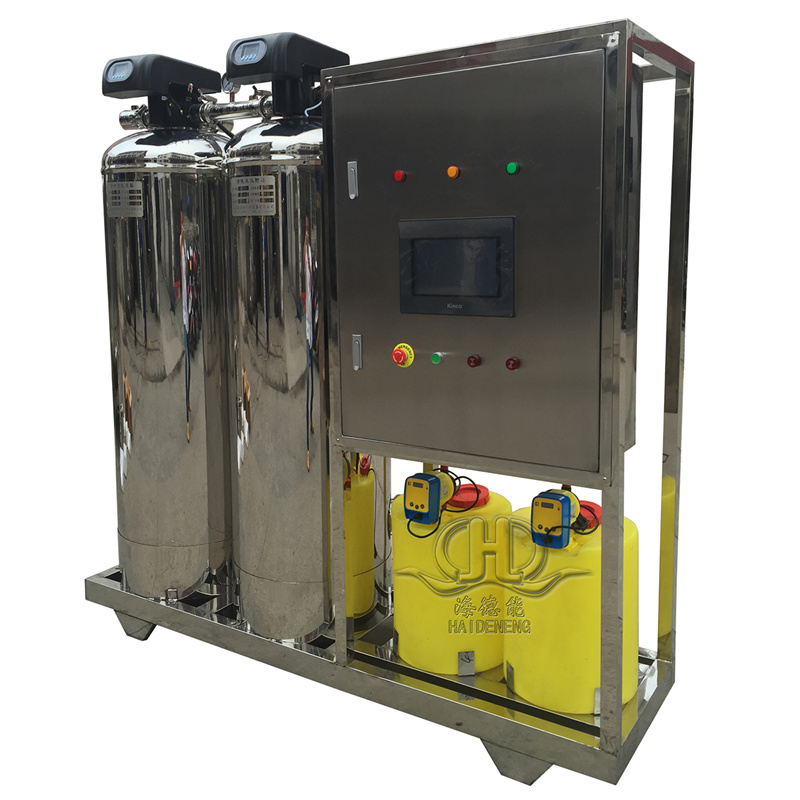Vertical reverse osmosis filtration salt ion automatic water treatment equipment
Product description
Working principle
Selective permeability of semi permeable membranes: By utilizing the characteristics of semi permeable membranes, only water is allowed to pass through, while impurities such as salt ions are blocked from passing through. For example, in seawater desalination, semi permeable membranes can effectively block the salt content in seawater, allowing only water molecules to pass through, thereby achieving seawater desalination.
Pressure driven: When an external pressure is applied to the saltwater chamber, and this pressure is greater than the osmotic pressure between the saltwater chamber and the freshwater chamber, a driving force is formed for water to move from the saltwater chamber to the freshwater chamber, allowing water to be filtered through a semi permeable membrane while salt ions and other substances are trapped on one side of the saltwater chamber.
Equipment structure
Reverse osmosis membrane element: It is the core component of equipment, usually using roll type, hollow fiber type and other structures, with extremely high desalination rate and water flux. These membrane components are composed of multiple layers of different materials, which can effectively block the passage of salt ions and other impurities.
Pressure vessel: used to accommodate reverse osmosis membrane components, usually made of high-strength fiberglass or stainless steel materials, capable of withstanding high pressure and ensuring the safe operation of equipment.
High pressure pump: provides the required pressure for water filtration, pressurizing the raw water to the pressure range where the reverse osmosis membrane can work normally. Generally, the inlet pressure is required to be around 0.2-0.4 MPa.
Pre treatment system: including multi-media filters, activated carbon filters, precision filters, etc., used to remove suspended solids, colloids, organic matter, residual chlorine and other impurities in raw water, and protect reverse osmosis membrane components from pollution and damage.
Control system: Adopting PLC programmable intelligent control system and human-machine interface operating system, it can achieve automatic operation, monitoring and management of equipment, real-time monitoring of water quality, water pressure, flow rate and other parameters, and automatically adjust and control according to the set values.
characteristic
High degree of automation: adopting advanced control systems, it can achieve functions such as automatic operation, automatic flushing, and automatic dosing, without the need for manual duty, reducing labor intensity and operating costs.
High desalination rate: It can effectively remove various salt ions from water, achieving high purity of the effluent water and meeting the water quality requirements of different industries. Generally, the desalination rate can reach over 99%.
Stable water quality: The RO-EDI desalination system ensures stable effluent quality without periodic changes like mixed beds, providing a stable and reliable water source for the production process.
Low operating costs: During the operation of the equipment, there is no need to use acidic or alkaline chemical agents for regeneration, reducing the cost of purchasing, storing, and handling chemicals, while also avoiding environmental pollution.
Small footprint: Due to the compact structure of the equipment, the footprint is relatively small, which can save factory space and is particularly suitable for use in places with limited space.
application area
Drinking water treatment: It can be used to remove impurities such as residual chlorine, heavy metals, pesticide residues, etc. from tap water, producing high-quality drinking water and meeting people’s demand for healthy drinking water.
Industrial wastewater treatment: It can effectively remove pollutants such as salt ions, organic matter, heavy metals, etc. from industrial wastewater, achieve standard discharge or reuse of wastewater, and reduce water resource waste and environmental pollution.
Seawater desalination: It is one of the main technologies for seawater desalination, which removes a large amount of salt from seawater through reverse osmosis filtration, producing fresh water that can be consumed by humans and used in industry.
Pharmaceutical industry: used for preparing purified water, injection water, etc. required in the pharmaceutical process to ensure the quality and safety of drugs.












